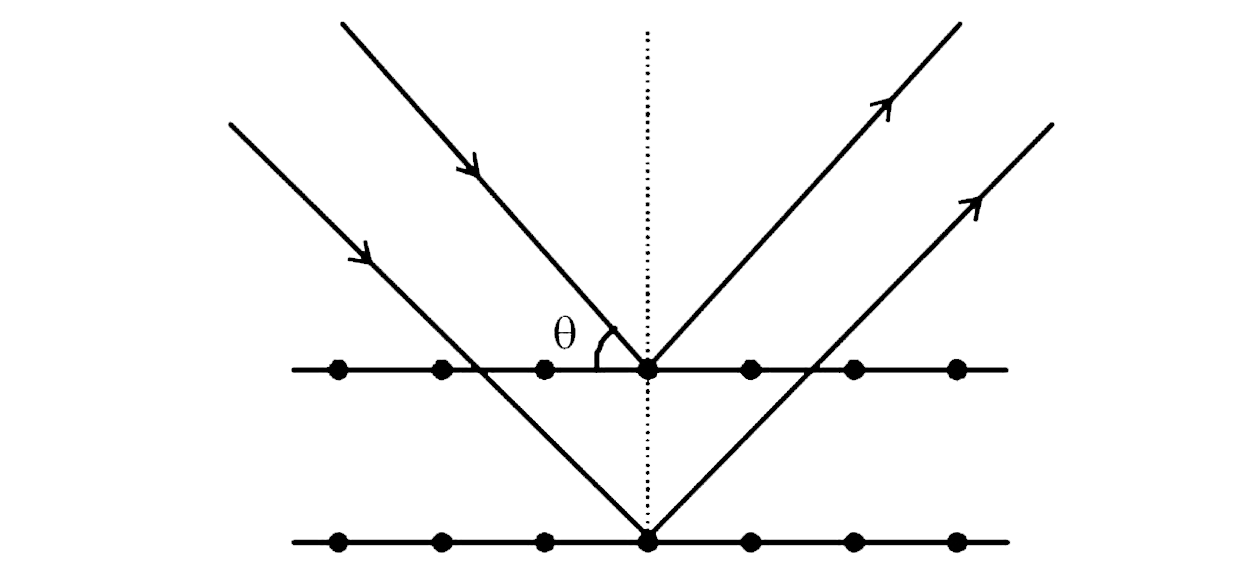Wave property of electron implies that they will show diffraction effected . Davisson and Germer demonstrated this by diffracting electron from crystals . The law governing the diffraction from a crystals is obtained by requiring that electron waves reflected from the planes of atoms in a crystal inter fere constructiely

Electron accelerated by potential V are diffracted from a crystal if d=1Åandi=30∘,V should be about (h=6.6×10−34Js,me=9.1×10−31kg,e=1.6×10−19C)
A
2000V
B
50V
C
500V
D
1000V
Video Solution
Text Solution
The correct Answer is:B
Using Bragg's equation 2dsinθ=nλ
Hrern=1,θ=90−1=90−30=60∘
2dsinθ=lanbda …..(i)

Also λ=12.27√V×10−10m ……(ii)
om(i)and(ii) 2 xx 10^(-10) xx sin 60^(@)= (12.27)/(sqrt(V)) xx 10^(-10)<br>v = ((12.27)^(2))/(3) = 50 V
|
Topper's Solved these Questions
- MODERN PHYSICSBOOK - SUNIL BATRA (41 YEARS IITJEE PHYSICS)CHAPTER - MODERN PHYSICSEXERCISE - MCQ (One Correct Answer
1 Videos
- ELECTROSTATICSBOOK - SUNIL BATRA (41 YEARS IITJEE PHYSICS)CHAPTER - ELECTROSTATICSEXERCISE - Comprehension Based Questions
2 Videos
- MOVING CHARGES AND MAGNETISMBOOK - SUNIL BATRA (41 YEARS IITJEE PHYSICS)CHAPTER - MOVING CHARGES AND MAGNETISMEXERCISE - MCQs(d )
1 Videos
Similar Questions
Knowledge Check
Wave property of electron implies that they will show diffraction effected . Davisson and Germer demonstrated this by diffracting electron from crystals . The law governing the diffraction from a crystals is obtained by requiring that electron waves reflected from the planes of atoms in a crystal inter fere constructiely

If a strong diffraction peak is observed when electrons are incident at an angle i from the normal to the crystal planes with distance d between them (see fig) de Brogle wavelength λdB of electrons can be calculated by the relationship (n is an intenger)Adsini=nλdBB2dcosi=nλdBC2dsini=nλdBDdcosi=nλdBWave property of electrons implies that they will show diffraction effects. Davission and Germer demonstrated this by diffracting electrons from crystals. The law governing the diffraction from a crystal is obtained by requiring that electron waves reflected from the planes of atoms in a crystal interfere constructively (see figure)
_E01_233_Q01.png)
The surface of a metal is illuminated with the light of 400nm. The kinetic energy of the ejected photoelectrons was found to be 1.68eV. The work function of the metal is : (hc=1240eV−nm)A1.51eVB1.68eVC3.09eVD1.42eVWave property of electrons implies that they will show diffraction effects. Davission and Germer demonstrated this by diffracting electrons from crystals. The law governing the diffraction from a crystal is obtained by requiring that electron waves reflected from the planes of atoms in a crystal interfere constructively (see figure)

In an experiment, electrons are made to pass through a narrow slit of width 'd' comparable to either de-Broglie wavelength. They are detected on a screen at a distance 'D' from the slit

The following graphs that can be expected to represent the number of electrons 'N' detected as a function of the detector position 'y' (y=0 corresponds to the middle of the slit) isA B
B C
C D
D
In a crystal, the permitted energy states of electrons are present
View SolutionIn Davisson and Germer experiment, a crystal which diffracts a beam of electrons is of
View SolutionAn electron trapped in an anion site in a crystal is called
View SolutionIn Davisson - Germer experiment Ni crystal acts as :
View SolutionThe angle corresponding to maximum diffraction of x-rays on solid crystal is determined by electrometre reading in
View Solution
